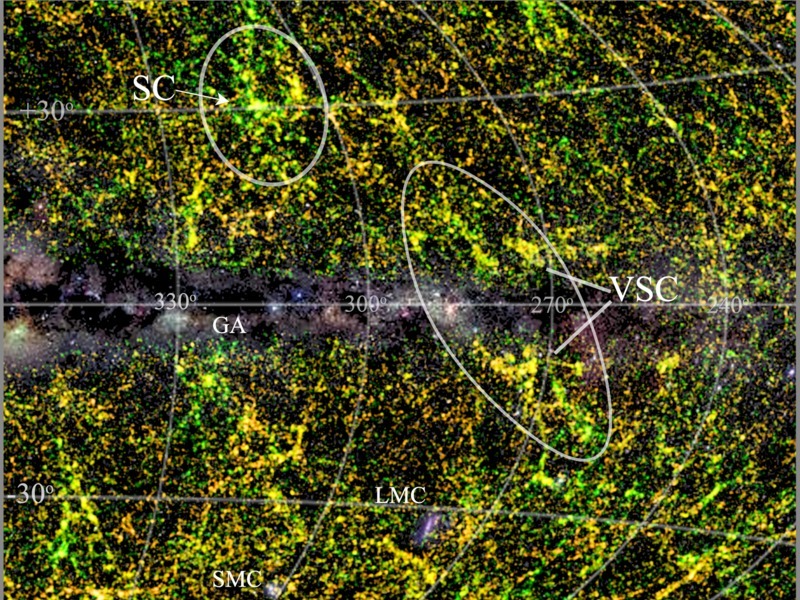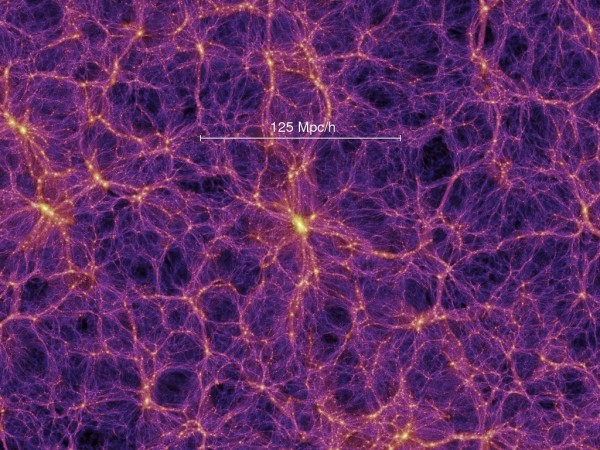
A team of astronomers from South Africa, the Netherlands, Germany, and Australia announced on November 16, 2016 the discovery of a previously unknown major concentration of galaxies in direction to the southern constellation Vela. They’ve dubbed it the Vela supercluster, and it’s one of perhaps 10 million superclusters of galaxies – vast collections of galaxies – the largest structures we know in the universe. The gravitational attraction from this newly found large mass concentration in our cosmic neighborhood might have an important effect on the motion of our Local Group of galaxies including the Milky Way, these astronomers said. It might also help to explain the direction and amplitude of our Local Group’s peculiar velocity with respect to the Cosmic Microwave Background.
Generally speaking, superclusters are vast clusters of galaxies spanning up to 200 million light-years across the sky. They’re not isolated in space but exist together with many other smaller concentrations of galaxies, together forming parts of extensive walls of galaxies surrounding large voids in what astronomers call the cosmic web.
Superclusters aren’t just big; they are also massive, meaning they have a powerful gravitational pull. They are the most massive known structures in our universe. A nearby supercluster famous for its great mass is the Shapley Supercluster, some 650 million light-years away containing two dozens of massive X-ray clusters for which thousands of galaxy velocities have been measured. It is believed to be the largest of its kind in our cosmic neighborhood.
The new Vela supercluster is slightly farther away (800 million light-years) and covers an even larger sky area than Shapley. The Vela supercluster had gone unnoticed due to its location behind the plane of the Milky Way, where dust and stars obscure background galaxies.
The team’s results suggest the Vela supercluster might be as massive as Shapley, which indicates that its influence on local bulk flows is comparable to that of Shapley.
Where is our galaxy in the universe?

These astronomers based their discovery on multi-object spectroscopic observations of thousands of partly obscured galaxies. Observations in 2012 with the refurbished spectrograph of the Southern African Large Telescope (SALT) confirmed that eight new clusters reside within the Vela area.
Subsequent spectroscopic observations with the Anglo-Australian Telescope in Australia provided thousands of galaxy redshifts and revealed the vast extent of this new structure.
Astronomer Renée Kraan-Korteweg from the University of Cape Town led this study. She has been investigating this region for more than a decade. When she and her colleagues analyzed the spectra of the new survey, she said:
I could not believe such a major structure would pop up so prominently.
Astronomers Hans Böhringer and Gayoung Chon from the Max-Planck-Institut für extraterrestrische Physik have surveyed the supercluster region for X-ray luminous galaxy clusters and found two massive clusters. They thus confirm:
This discovery shows that the Vela supercluster has a significantly higher matter density than average, making it a prominent large structure.
Follow-up observations are needed to unveil the full extent, mass, and influence of the Vela supercluster, these astronomers said.
So far this region of the sky is sparsely sampled, while the part closest to the Milky Way has not been probed because dense star and dust layers block our view.
Gayoung Chon added:
We already have good indications that the Vela Supercluster is embedded in a large network of cosmic filaments traced by clusters, providing insight into the even larger-scale structure embedding the Vela Supercluster. With the future multi-wavelength programme we hope to unveil its full influence on the cosmography and cosmology.

Bottom line: A team of astronomers from South Africa, the Netherlands, Germany, and Australia announced on November 16, 2016 the discovery of a previously unknown major concentration of galaxies in direction to the southern constellation Vela. They’ve dubbed it the Vela supercluster.











